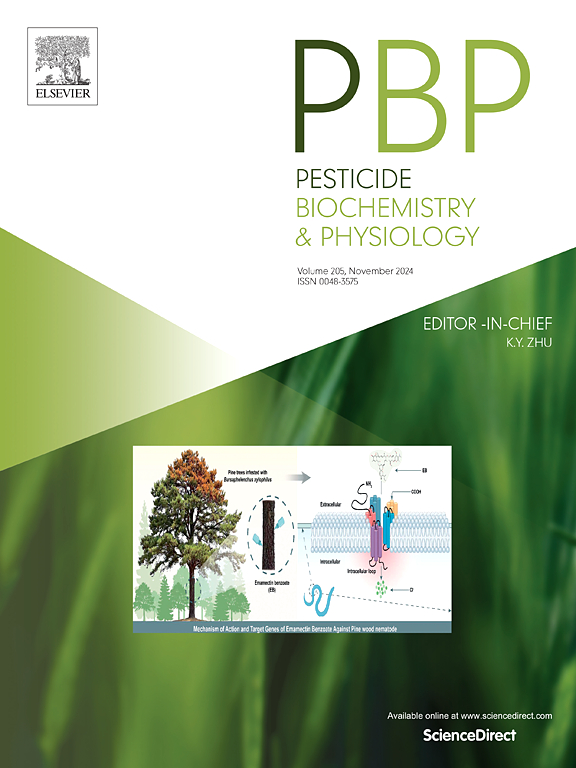甲苯吡虫啉在土栽和水培菊苣(菊苣)中的转运、分布和代谢及其潜在健康风险评估
IF 4.2
1区 农林科学
Q2 BIOCHEMISTRY & MOLECULAR BIOLOGY
引用次数: 0
摘要
甲苯吡虫胺广泛用于农业;然而,苯虫吡酯在作物中的环境影响尚未得到明确证明。在土壤栽培和水培条件下,研究了菊苣中苯虫吡酯的迁移和分布。菊苣根由于具有较高的生物浓度因子,极易从培养基中吸收和积累苯氰菊酯(>;比;1).水培蔓生植物除易于向下易位(易位因子(TFs)接近1)外,向上和向下易位受到限制(TF <;1)此外,鉴定出3种代谢物。苯醚吡拉德在水培菊科植物中消散迅速(半衰期为5.2 ~ 6.9 d),健康风险可接受(风险商数为100%)。这些发现可能与苯氰菊酯的疏水性有关,也可能与菊苣在不同栽培条件下的特定形态和生长速率有关。研究结果为消费者合理使用苯氰吡虫啉和预防作物风险提供了依据。本文章由计算机程序翻译,如有差异,请以英文原文为准。

Translocation, distribution, and metabolism of tolfenpyrad in soil-cultivated and hydroponic endive (Cichorium endivia) and the assessment of potential health risk
Tolfenpyrad is broadly used in the agricultural industry; however, the environmental fate of tolfenpyrad in crops has not been clearly demonstrated. In this work, the translocation and distribution of tolfenpyrad were investigated in endive under soil-cultivated and hydroponic conditions. Endive roots can easily absorb and accumulate tolfenpyrad from cultivation media due to the high bioconcentration factors (> > 1). Except for the easy downward translocation in hydroponic endive (translocation factors (TFs) close to 1), the upward and downward translocation was limited (TF < 1). Moreover, three metabolites were identified. Tolfenpyrad dissipated quickly in hydroponic endive (half-lives of 5.2–6.9 d) and the health risk is acceptable (risk quotient <100 %). These findings may be attributed to the hydrophobicity of tolfenpyrad, as well as specific morphological and growth rate properties of endive under different cultivation conditions. The results provide information for the proper application of tolfenpyrad and risk prevention in crops for consumers.
求助全文
通过发布文献求助,成功后即可免费获取论文全文。
去求助
来源期刊
CiteScore
7.00
自引率
8.50%
发文量
238
审稿时长
4.2 months
期刊介绍:
Pesticide Biochemistry and Physiology publishes original scientific articles pertaining to the mode of action of plant protection agents such as insecticides, fungicides, herbicides, and similar compounds, including nonlethal pest control agents, biosynthesis of pheromones, hormones, and plant resistance agents. Manuscripts may include a biochemical, physiological, or molecular study for an understanding of comparative toxicology or selective toxicity of both target and nontarget organisms. Particular interest will be given to studies on the molecular biology of pest control, toxicology, and pesticide resistance.
Research Areas Emphasized Include the Biochemistry and Physiology of:
• Comparative toxicity
• Mode of action
• Pathophysiology
• Plant growth regulators
• Resistance
• Other effects of pesticides on both parasites and hosts.

 求助内容:
求助内容: 应助结果提醒方式:
应助结果提醒方式:


